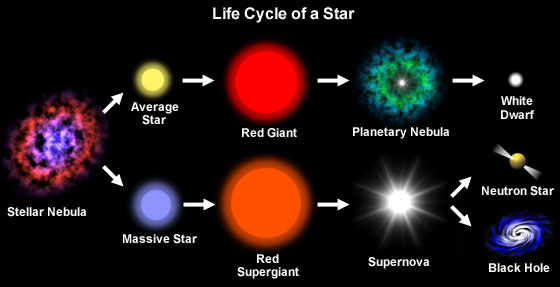Just like life on Earth, stars also have a life cycle where they are born, grow old then die. This can then cycle round and new stars are born.
The life cycle of a star is as follows:
- Out in space, clouds of dust clump together and shrink due to gravity. The friction generates heat.
- The shrinking cloud breaks into smaller clumps each of which form a protostar.
- The protostar is shrouded in gas which flattens into a disk as the star spins.
- Eventually, the star comes to life and strong jets of gas escape either side.
- Dust grains clump together in a disk around the protostar and may eventually form planets.
- The young star is now fusing Hydrogen into Helium and lives out the main stage of its life.
- As the Hydrogen runs out, the star expands to become a red supergiant.
- The core is hotter and the star now fuses helium to form Oxygen and Carbon.
- Nuclear reactions keep going bulding heavier and heavier elements until a core of iron forms.
- Eventually, the iron core collapses forming a brilliant supernova explosion expelling all of its outer material.
- Depending on the mass of the remaining core it becomes either a neutron star, or a black hole.
- The material expelled in the supernova can join other clouds and form new stars and thus the cycle is complete.
Note, not all stars follow the above cycle. Smaller stars such as our Sun, would stop fusing elements after they have run out of helium and simply 'puff' off its outer layers. The remaining core becomes a white dwarf which slowly fades over billions of years.


